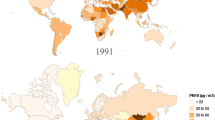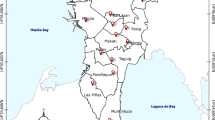Abstract
A field study was carried out at six locations in the Lazio region (Central Italy) aimed at characterising atmospheric particulate matter (PM10 and PM2.5) from the point of view of the chemical composition and grain size distribution of the particles, the mixing properties of the atmosphere, the frequency and relevance of natural events. The combination of four different analytical techniques (ion chromatography, X-ray fluorescence and ICP for inorganic components, thermo-optical analysis for carbon compounds) yielded sound results in terms of characterisation of the air masses. During the first three months of the study (October-December 2004), many pollution events of natural (sea-salt or desert dust episodes) or anthropogenic nature were identified and characterised. More than 90% of the collected mass was identified by chemical analysis. The central role played by the mixing properties of the lower atmosphere when pollution events occurred was highlighted. The results show a major impact of primary anthropogenic pollutants on traffic stations and a homogeneous distribution of secondary pollutants over the regional area. An evaluation of the sources of PM and an identification of possible reliable tracers were obtained using a chemical fractionation procedure.
Similar content being viewed by others
References
Alastuey, A., Querol, X., Castello, S., Escudero, M., Avila, A., Cuevas, E., Torres, C., Romero, P. M., Exposito, F., Garci a, O., Diaz, J. P., Van Dingenen, R., & Putaud, J.P. (2005). Characterisation of TSP and PM2.5 at Izana and Sta. Cruz de Tenerife (Canary Islands, Spain) during a Saharan Dust Episode (July 2002). Atmospheric Environment, 39, 4715–4728.
Almeida, S. M., Pio, C. A.,. Freitas, M. C., Reis, M. A., & Trancoso, M. A. (2005). Source apportionment of fine and coarse particulate matter in a sub-urban area at the Western European Coast. Atmospheric Environment, 39, 3127–3138.
Arti nano, B., Salvador, P., Alonso, D. G., Querol, X., & Alastuey, A. (2003). Anthropogenic and natural influence on the PM10 and PM2.5 aerosol in Madrid (Spain). Analysis of high concentration episodes. Environmental Pollution, 125, 453–465.
Artinano, B., Querol, X., Salvador, P., Rodriguez, S., Alonso, D. G., & Alastuey, A. (2001). Assessment of airborne particulate levels in Spain in relation to the new EU-Directive, Atmospheric Environment 35, S43–S53.
Astolfi, M. L., Canepari, S., Catrambone, M., Perrino, C., & Pietrodangelo, A. (2006). Improved characterisation of inorganic components in airborne particulate matter. Environmental Chemical Letters, In press.
Canepari, S., Cardarelli, E., Giuliano, A., & Pietrodangelo, A. (2006a). Determination of metals and non volatile ions in airborne particulate matter by a new two-step sequential leaching procedure. Part A: experimental design and optimisation, Talanta in press.
Canepari, S., Cardarelli, E., Pietrodangelo, A., & Strincone, M. (2006b). Determination of metals, metalloids and non-volatile ions in airborne particulate matter by a new two-step sequential leaching procedure. Part B: Validation on equivalent real samples, Talanta in press.
Chan, Y. C., Simpson, R. W., McTainsh, G. H., & Vowles, P. D. (1997). Characterisation of chemical species in PM2.5 and PM10 aerosols in Brisbane, Australia. Atmospheric Environment, 31, 3773–3785.
Cohen, D. D., Gulson, B. L., Davis, J. M., Stelcer, E., Garton, D., Hawas, O., & Taylor A. (2005). Fine-particle Mn and other metals linked to the introduction of MMT into gasoline in Sydney, Australia: Results of a natural experiment. Atmospheric Environment, 39, 6885–6896.
EN 14902 (2005). Ambient air quality–Standard method for the measurement of Pb, Cd, As and Ni in the PM10 fraction of suspended particulate matter.
Goudie, A. S., & Middleton, N. J. (2001). Saharan dust storms: nature and consequences. Earth Science Reviews, 56, 179–204.
Gomez, D. R., Giné, M. F., Sanchez Bellato, A. C., & Smichowski, P. (2005). Antimony: a traffic-related element in the atmosphere of Buenos Aires, Argentina. Journal of Environmental Monitering, 7, 1162–1168.
Graham, B., Falkovich, A. H., Rudich, Y., Maenhaut, W., Guyon, P., & Andrae, M. O. (2004). Local and regional contributions to the atmospheric aerosol over Tel Aviv, Israel: a case study using elemental, ionic and organic tracers. Atmospheric Environment, 38, 1593–1604.
Harrison, R. M., & Yin, J. (2000). Particulate matter in the atmosphere: which particle properties are important for its effects on health? Science of the Total Environment, 249, 85–101.
Harrison, R. M., Alan, M. J., & Royston, G. L. (2003). A pragmatic mass closure model for airborne particulate matter at urban background and roadside sites. Atmospheric Environment, 37, 4927–4933.
Heal, M. R., Hibbs, L. R., Agius, R. M., & Beverland, I. J. (2005). Total and water-soluble trace metal content of urban 0background PM10, PM2.5 and black smoke in Edinburgh, UK. Atmospheric Environment, 39, 1417–1430.
Hoenig, M., Docekalova, H., & Baeten, H. (2000). Additional consideration for trace element analysis of environmental matrces using inductively coupled plasma atomic emission spectrometry with ultrasonic nebulization. Analysis, 28, 419–425.
Hsu, S. C., Lin, F. J., & Jeng, W. L. Seawater solubility of natural and anthropogenic metals within ambient aerosols collected from Taiwan coastal sites. Atmospheric Environment, 39, 3989–4001.
Hueglin, C., Gehrig, R., Baltensperger, U., Gysel, M., Monn, C., & Vonmont, H. (2005). Chemical characterisation of PM2.5, PM10 and coarse particles at urban, near-city and rural sites in Switzerland. Atmospheric Environment, 39, 637–651.
Kataoka, T., Yunoki, E., Shimizu, M., & Mori, T. (2001). A study of the atmospheric boundary layer using radon and air pollutants as tracer. Boundary-Layer Metereol, 101, 131–155.
Laden, F., Neas, L. M., Dockery, D. W., & Schwartz, J. (2000). Association of fine particulate matter from different sources with daily mortality in six US cities. Environmental Health Perspect 108, 941–947.
Lehmann, K., Massling, A., Tilgner, A., Mertes, S., Galgon, D., & Wiedensohler, A. (2005). Size-resolved soluble volume fractions of submicrometer particles in air masses of different character. Atmospheric Environment, 39, 4257–4266.
Liu, W., Wang, Y., Russell, A., & Edgerton, E. S. (2005). Atmospheric aerosol over two urban–rural pairs in the southeastern United States: Chemical composition and possible sources. Atmospheric Environment, 39, 4453–4470.
Mar, T. F., Norris, G. A., Koenig, J. Q., & Larson, T. V. (2000). Associations between air pollution and mortality in Phoenix, 1995–1997. Environmental Health Perspect, 108, 347–353.
Marcazzan, G. M., Vaccaro, S., Valli, G., & Vecchi, R. (2001). Characterisation of PM10 and PM2.5 particulate matter in the ambient air of Milan (Italy), Atmospheric Environment, 35, 4639–4650.
Maenhaut, W., Raes, N., Chi, X., Cafmeyer, J., Wang, W., & Salma, I. (2005). Chemical Composition and mass closure for fine and coarse aerosols at a kerbisite in Budapest, Hungary, in spring 2002. X-Ray Spectrometry, 34, 290–296.
Mohamed, A. H. E., Injuk, J., Maenhaut, W., & Van Grieken, R. E. (2001). Elemental composition of Mineral aerosol generated from Sudan Sahara sand. Journal of Atmospheric Chemistry, 40, 247–273.
Pakkanen, T. A., Kerminen, Loukkola, V. K., Hillamo, R. E., Aarnio, P., Koskentalo, T., & Maenhaut, W. (2003) Size distributions of mass and chemicalcomponents in street-level and rooftop PM1 particles in Helsinki. Atmospheric Environment, 37, 1673–1690.
Perrino, C., Febo, A., & Allegrini I. (2000). A new beta gauge monitor for the measurement of PM10 air concentration Proc. of the EMEP-WMO workshop on fine particles—emissions, modelling and measurements, EMEP/CCC Report 9/2000, J. E. Hanssen, R. Ballaman & R. Gehrig Eds., pp. 147–152.
Perrino, C., Pietrodangelo, A., & Febo, A. (2001). An atmospheric stability index based on radon progeny measurements for the evaluation of primary urban pollution. Atmospheric Environment, 35, 5235–5244.
Putaud, J. P. et al., A European aerosol phenomenology-2: chemical characteristics of particulate matter at kerbside, urban, rural and background sites in Europe, Atmospheric Environment, 38, 2579–2595.
Querol, X., et al. (2004). Speciation and origin of PM10 and PM2.5 in selected European cities. Atmospheric Environment, 38, 6547–6555.
Salma, I., Ocskay, R., Raes, N., & Maenhaut W. (2005). Fine structure of mass size distributions in an urban environment. Atmospheric Environment, 39, 5363– 5374.
Samet, J. M., Dominici, F., Curriero, F. C., Coursac, I., & Zeger, S. L. (2000). Fine particulate air pollution and mortality in 20 US cities, 1987–1994, New England Journal of Medicine, 343, 1742–1799.
Schlesinger, R. B. (1995). Toxicological evidence for health effects from inhaled particulate matter, Inhalation Toxicology, 7, 99–109.
Schwartz, J. (1994). What are people dying of on high pollution days, Environmental Research, 64, 26–35.
Sesana, L., Caprioli, E., & Marcazzan, G. M. (2003). Long period study of outdoor radon concentration in Milan and correlation between its temporal variation and dipersion properties of the atmosphere, Journal of Environment Radioactivity, 65, 147–160.
Shweikani, R., Giadutt, T. G., & Durrani S. A. (1995). The effect of soil parameters on radon concentration values in the environment, Radiation Measurement, 25, 581–584.
Smichowski, P., Gomez, D. R., Dawidowski, L. E., Giné, M. F.,Sanchez Bellato, A. C., & Reich, S. L. (2004). Monitoring trace metals in urbanaerosols from Buenos Aires city. Determination by plasma-basedtechniques., Journal of Environmental Monitoring, 6, 286–294.
Smichowski, P., Polla, G., & Gomez D. (2005). Metal fractionation of atmospheric aerosols via sequential chemical extraction: a review., Analytical and Bioanalytical Chemistry, 381, 302–316.
Sternbeck, J., Sjodin, A., & Andreasson, K.(2002). Metal emissions from road traffic and the influence of resuspension-results from two tunnel studies., Atmospheric Environment, 36, 4735–4744.
Turpin, B. J., & Lim, H. (2001). Species contribution to PM2.5 mass concentration: revisiting common assumptions for estimating organic mass., Aerosol Science and Technology, 35, 602–610.
Vecchi, R., Marcazzan, G., Valli, G., Cerini, M., & Antoniazzi, C. (2004). The role of atmospheric dispersion in the seasonal variation of PM1 and PM2.5 concentration and composition in the urban area of Milan (Italy). Atmospheric Environment, 38, 4437–4446.
Voutsa, D., Samara, C., Kouimtzis, & Ochsenkuhn, K. (2002). Elemental composition of airborne particulate matter in the multi-impacted urban area of Thessaloniki, Greece. Atmospheric Environment, 36, 4453–4462.
Weckwerth, G. (2001). Verification of traffic emitted aerosol components in the ambient air of Cologne (Germany). Atmospheric Environment, 35, 5525–5536.
Zhang, K. M., Knipping, E. M., Anthony, S., Wexler, A. S., Bhave, P. V., & Tonnesen, G. S. (2005). Size distribution of sea-salt emissions as a function of relative humidity. Atmospheric Environment, 39, 3373–3379.
Author information
Authors and Affiliations
Corresponding author
Rights and permissions
About this article
Cite this article
Perrino, C., Canepari, S., Cardarelli, E. et al. Inorganic constituents of urban air pollution in the Lazio region (Central Italy). Environ Monit Assess 128, 133–151 (2007). https://doi.org/10.1007/s10661-006-9269-7
Received:
Accepted:
Published:
Issue Date:
DOI: https://doi.org/10.1007/s10661-006-9269-7




